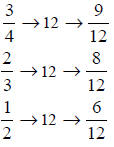- Home
- INTERMEDIATE ALGEBRA
- Course Syllabus for Algebra I
- Mid-Plains Community College
- FRACTION OF A WHOLE NUMBER
- Systems of Linear Equations
- MATH FIELD DAY
- Course Outline for Finite Mathematics
- Calculus
- Algebra Final Examination
- Math 310 Exam #2
- Review of Trigonometric Functions
- Math 118 Practice test
- Precalculus Review
- Section 12
- Literal Equations
- Calculus Term Definitions
- Math 327A Exercise 2
- Public Key Algorithms II
- Maximizing Triangle Area
- Precalculus I Review for Midterm
- REVIEW OF A FIRST COURSE IN LINEAR ALGEBRA
- Math 6310 Homework 5
- Some Proofs of the Existence of Irrational Numbers
- ALGEBRAIC PROPERTIES OF MATRIX OPERATIONS
- Math 142 - Chapter 2 Lecture Notes
- Math 112 syllabus
- Math 371 Problem Set
- Complex Numbers,Complex Functions and Contour Integrals
- APPLICATIONS OF LINEAR EQUATIONS
- Week 4 Math
- Fractions
- Investigating Liner Equations Using Graphing Calculator
- MATH 23 FINAL EXAM REVIEW
- Algebra 1
- PYTHAGOREAN THEOREM AND DISTANCE FORMULA
- Georgia Performance Standards Framework for Mathematics - Grade 6
- Intermediate Algebra
- Introduction to Fractions
- FACTORINGS OF QUADRATIC FUNCTIONS
- Elementary Algebra Syllabus
- Description of Mathematics
- Integration Review Solutions
- College Algebra - Applications
- A Tip Sheet on GREATEST COMMON FACTOR
- Syllabus for Elementary Algebra
- College Algebra II and Analytic Geometry
- Functions
- BASIC MATHEMATICS
- Quadratic Equations
- Language Arts, Math, Science, Social Studies, Char
- Fractions and Decimals
- ON SOLUTIONS OF LINEAR EQUATIONS
- Math 35 Practice Final
- Solving Equations
- Introduction to Symbolic Computation
- Course Syllabus for Math 935
- Fractions
- Fabulous Fractions
- Archimedean Property and Distribution of Q in R
- Algebra for Calculus
- Math112 Practice Test #2
- College Algebra and Trigonometry
- ALGEBRA 1A TASKS
- Description of Mathematics
- Simplifying Expressions
- Imaginary and Complex Numbers
- Building and Teaching a Math Enhancement
- Math Problems
- Algebra of Matrices Systems of Linear Equations
- Survey of Algebra
- Approximation of irrational numbers
- More about Quadratic Functions
- Long Division
- Algebraic Properties of Matrix Operation
- MATH 101 Intermediate Algebra
- Rational Number Project
- Departmental Syllabus for Finite Mathematics
- WRITTEN HOMEWORK ASSIGNMENT
- Description of Mathematics
- Rationalize Denominators
- Math Proficiency Placement Exam
- linear Equations
- Description of Mathematics & Statistics
- Systems of Linear Equations
- Algebraic Thinking
- Study Sheets - Decimals
- An Overview of Babylonian Mathematics
- Mathematics 115 - College Algebra
- Complex Numbers,Complex Functions and Contour Integrals
- Growing Circles
- Algebra II Course Curriculum
- The Natural Logarithmic Function: Integration
- Rational Expressions
- QUANTITATIVE METHODS
- Basic Facts about Rational Funct
- Statistics
- MAT 1033 FINAL WORKSHOP REVIEW
- Measurements Significant figures
- Pre-Calculus 1
- Compositions and Inverses of Functions
Fractions and Decimals
Terms
| Numerator: which tells how many parts you have (the number on top) | → |  |
| Denominator: which tells how many parts in the whole (the number on the bottom) | → |
Example:
 |
is 3 parts have a dot out of 4 |
Proper fraction: the top number is less than the bottom number.
Ex:

Improper fraction: the top number is equal to or is larger than the bottom number.
Ex:

Mixed Number: a whole number is written next to a proper fraction.
Ex:

Common Denominator: is a number that can be divided evenly by all of the denominators in the problem
Ex:

The common denominator for these
fractions will be 12. It also happens to
be least common denominator.
Reducing Fractions to Lowest Terms
Example:

Step 1: Find a number that goes evenly into the
numerator and the denominator of the fraction. With the
fraction to the left, the number that will go in evenly is 8.

Step 2: Check to see whether another number goes
evenly into both the numerator and denominator. Stop
when there are no more numbers that can go into the fraction.
In the example, the fraction can be reduced further by dividing it by 2.
Changing Mixed Numbers to Improper Fractions
Example: Change  to an improper fraction.
to an improper fraction.
 |
Step 1: Multiply the denominator by the whole number. |
 |
Step 2: Add the result to the numerator. |
 |
Step 3: Place the total over the denominator |
Adding and Subtracting Fractions With Different Bottom Numbers
Example 1: |
Example 2: |
|
 |
Step 1: Need to find the common denominator for all fractions |
 |
 |
Step 2: Then go ahead and add or subtract the fractions. |
 |
*Remember to change improper fractions to a mixed number.
Multiplying Fractions

Multiply the numerators across. Then multiply the
denominators across. Make sure the product is in lowest terms.
Multiplying with Mixed Numbers
Example:

 |
Step 1: Change every mixed fraction to an improper fraction. |
 |
Step 2: The multiply across. |
 |
Step 3: Then, change the improper fraction to a mixed number in lowest terms. |
Dividing Fractions
Example:

The fraction that is right of the division sign will need
to be turned upside down by writing the numerator in the denominator
and the denominator in the numerator. Then follow the rules for multiplying
fractions.

Practice:
1. Change  to an
improper fraction
to an
improper fraction
2. Change to a mixed
number.
to a mixed
number.

Answers:



